Tea ceremonies worldwide offer a fascinating glimpse into diverse cultures and traditions. You'll discover the serene Japanese Chanoyu, the meticulous Chinese Gongfu ritual, and the social British Afternoon Tea. Experience the warmth of Russian Samovar customs, the hospitality of Moroccan Mint Tea, and the unique flavors of Tibetan Butter Tea. Participate in Argentine Mate sharing circles, observe Korean tea etiquette, and enjoy the invigorating Thai Cha-yen. Each ceremony reflects its culture's values, emphasizing mindfulness, respect, and social connection. These rituals go beyond mere beverage preparation, serving as a medium for fostering community spirit and strengthening bonds among participants. Exploring these traditions will reveal a rich tapestry of global tea culture.
Japanese Chanoyu Ceremony
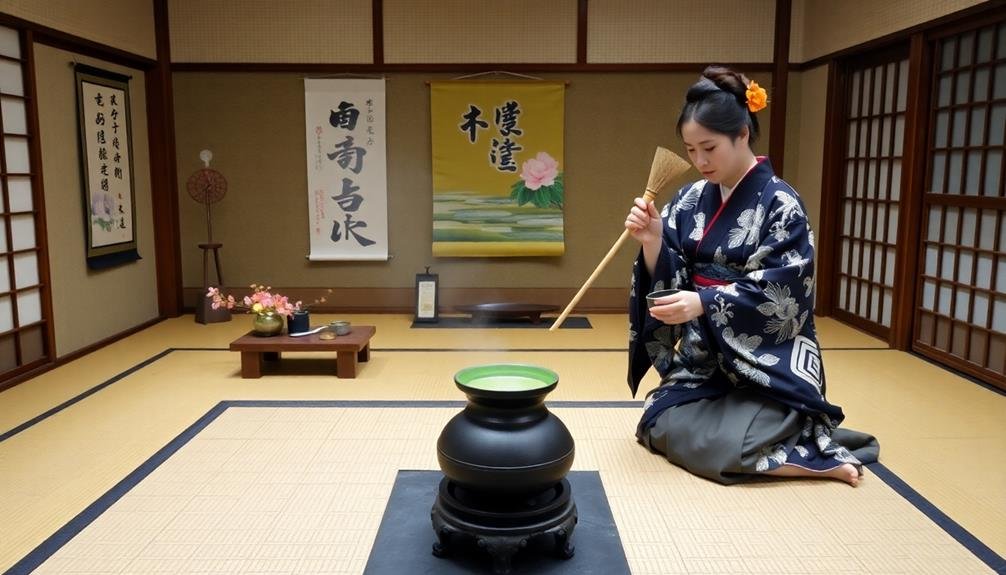
The Japanese Chanoyu ceremony, often called the Way of Tea, is a centuries-old ritual steeped in tradition and mindfulness. You'll find its roots in Zen Buddhism, emphasizing harmony, respect, purity, and tranquility.
As a guest, you'll be seated in a traditional tea room, or chashitsu, where every detail has been carefully considered. The host will meticulously clean and prepare the tea utensils before your eyes. You'll observe as they whisk the vibrant green matcha powder with hot water, creating a frothy brew.
The tea bowl, or chawan, is then passed to you with a respectful bow. Before drinking, you'll admire the bowl's craftsmanship and rotate it to avoid sipping from its front.
The ceremony isn't just about tea; it's a multisensory experience. You'll savor small sweets to balance the tea's bitterness and appreciate the room's aesthetics, from the hanging scroll to the flower arrangement.
The Chanoyu ceremony can last up to four hours, requiring patience and mindfulness. It's a practice that encourages you to be fully present, appreciating the beauty in simplicity and the art of hospitality.
Chinese Gongfu Tea Ritual
China's Gongfu tea ritual, often referred to as the "kung fu" of tea preparation, is a precise and skillful method of brewing tea.
You'll find this ceremony typically focuses on oolong or pu-erh teas, using small clay teapots and cups. The ritual emphasizes the tea's aroma, taste, and mouthfeel, aiming to extract the best flavors from the leaves.
To begin, you'll warm the teapot and cups with hot water. Next, you'll add tea leaves to the pot, rinse them briefly, and discard the water. This step "awakens" the leaves.
You'll then steep the tea for a short time, usually 20-30 seconds, and pour it into a serving pitcher. From there, you'll distribute the tea into small cups for tasting.
What sets Gongfu apart is its multiple infusions. You'll repeat the steeping process several times, with each infusion revealing different aspects of the tea's flavor profile.
As you progress, you'll increase the steeping time slightly to compensate for the leaves' diminishing strength. This method allows you to fully appreciate the tea's complexity and evolution throughout the session.
British Afternoon Tea Tradition
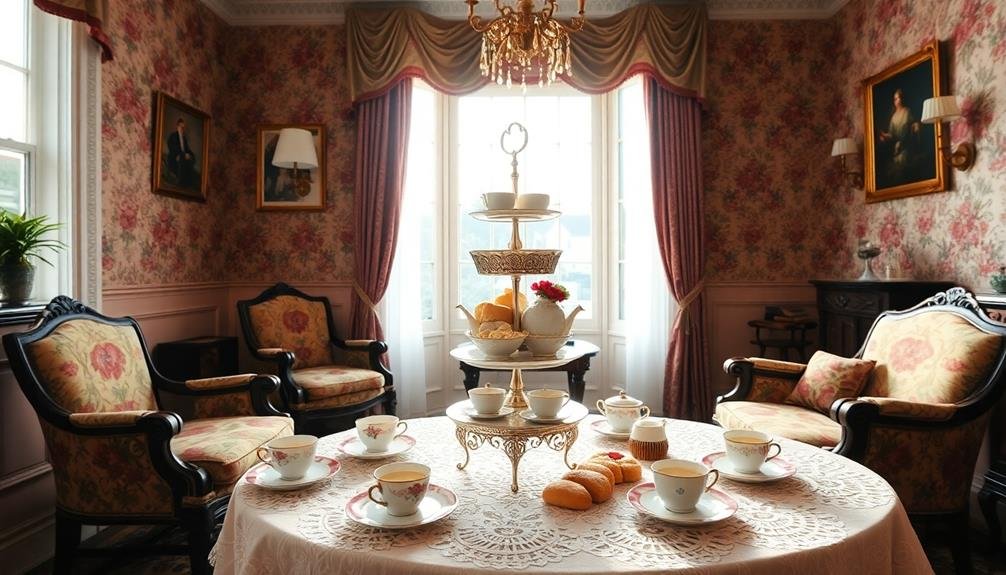
British afternoon tea tradition dates back to the 1840s, when Anna, the Duchess of Bedford, introduced it to stave off hunger between lunch and dinner. This custom quickly spread among the upper classes and eventually became a beloved British institution.
Today, you'll find afternoon tea served in hotels, tea rooms, and homes across the UK.
A typical British afternoon tea includes:
- A selection of finger sandwiches with various fillings
- Scones served with clotted cream and jam
- An assortment of sweet pastries and cakes
You'll usually be offered a choice of teas, ranging from classic English Breakfast to fragrant Earl Grey. The tea is traditionally served in fine china cups, accompanied by milk and sugar. It's customary to pour the tea first, then add milk if desired.
When attending an afternoon tea, you'll want to dress smartly and mind your manners. Use the small fork and knife provided for your scones, and remember to place your napkin on your lap.
Don't rush – afternoon tea is meant to be a leisurely, sociable affair. Enjoy the opportunity to relax and indulge in this quintessentially British tradition.
Russian Samovar Tea Custom
Russian samovar tea custom has been a cornerstone of social gatherings for centuries. You'll find the samovar, a large ornate urn, at the heart of this tradition. It's used to heat and boil water for tea, creating a focal point for conversation and hospitality.
When you participate in a Russian tea ceremony, you'll notice the distinct process. First, you'll brew a strong tea concentrate called zavarka in a small teapot. Then, you'll dilute it with hot water from the samovar to your desired strength. Russians often enjoy their tea with sugar, lemon, or jam, adding a unique twist to the flavor.
The ritual isn't just about the tea itself. It's a social event where you'll spend hours chatting, snacking on sweets, and enjoying each other's company. You'll find samovars in homes, restaurants, and even on trains, highlighting their cultural significance.
As you sip your tea, you'll notice it's typically served in glass cups held in metal holders called podstakanniki. This custom reflects the Russian preference for strong, hot tea and adds to the overall experience of the samovar tradition.
Moroccan Mint Tea Service
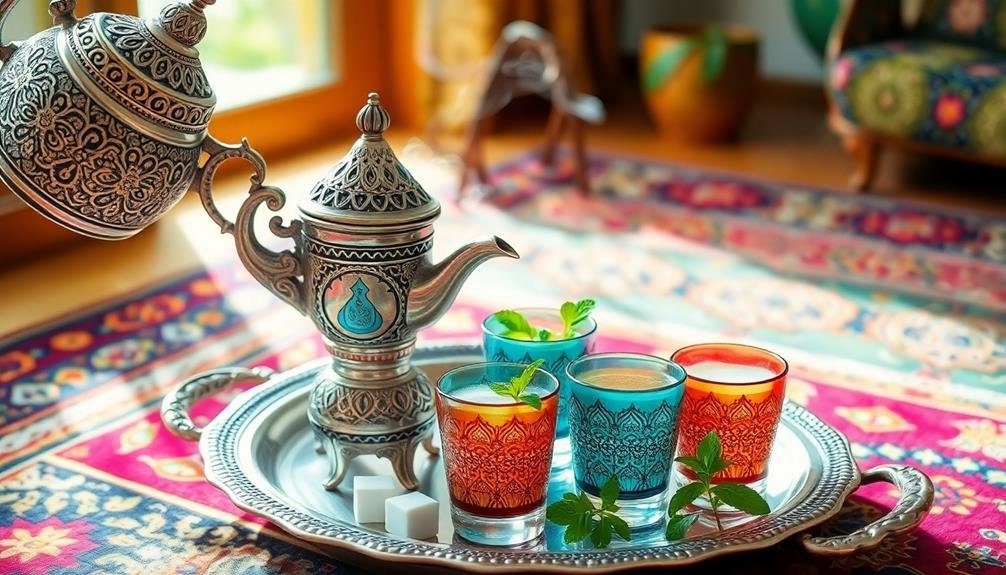
Moving from Russia's hearty samovar tradition, we encounter the vibrant Moroccan mint tea service. You'll find this ritual deeply rooted in Moroccan culture, symbolizing hospitality and friendship. As a guest, you're likely to be offered this invigorating beverage multiple times throughout your visit.
The preparation is an art form in itself. You'll watch as your host skillfully pours the tea from a height, creating a frothy top and aerating the drink. The process typically involves three rounds of serving, each with its own significance:
- The first glass is bitter like life
- The second is strong like love
- The third is sweet like death
You'll notice the distinct aroma of spearmint leaves, which are added generously to Chinese gunpowder green tea. The mixture is sweetened with sugar, creating a unique blend of flavors.
As you sip, you'll appreciate the intricate silver teapots and colorful glass cups, often adorned with traditional Moroccan designs. This ceremony isn't just about the tea; it's a social event, encouraging conversation and strengthening bonds between friends and family.
Indian Masala Chai Culture
Steeped in tradition, Indian masala chai culture offers a unique sensory experience that's both comforting and invigorating. As you explore this beloved beverage, you'll discover a rich tapestry of flavors and customs that have evolved over centuries.
To make authentic masala chai, you'll need black tea, milk, water, and a blend of aromatic spices. Typically, these include cardamom, cinnamon, ginger, cloves, and black peppercorns. The preparation process involves boiling these ingredients together, resulting in a fragrant, creamy concoction that's both sweet and spicy.
In India, you'll find chai wallahs (tea vendors) on almost every street corner, serving this beloved drink in small clay cups called kulhads. It's common to see people gathered around these stalls, engaging in lively conversations while sipping their chai.
Masala chai isn't just a beverage; it's an integral part of Indian hospitality. When visiting someone's home, you'll likely be offered a cup as a gesture of welcome. The act of sharing chai fosters social connections and creates a sense of community, making it an essential element of Indian culture.
Turkish Çay Offering
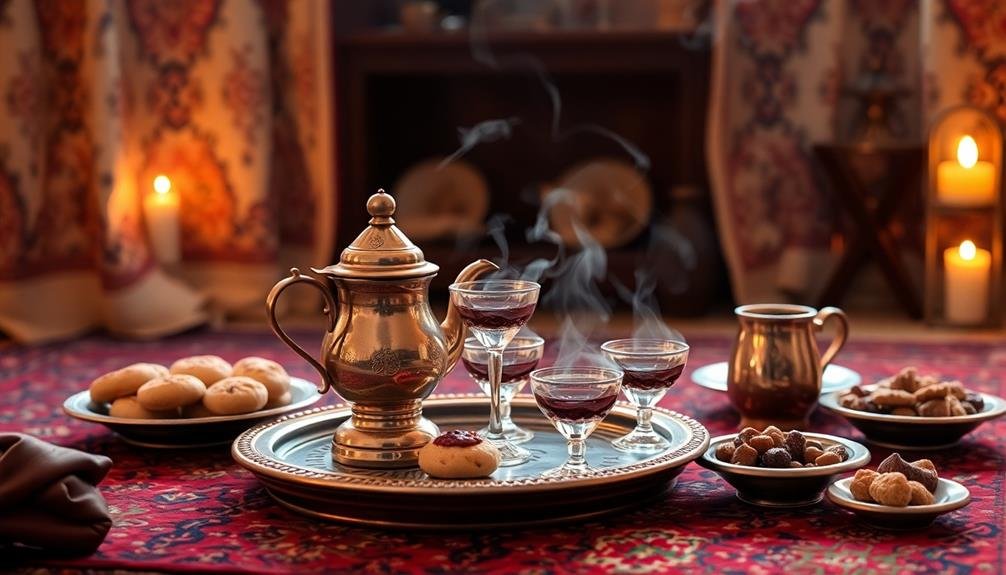
You'll find Turkish çay (tea) at the heart of daily life and hospitality in Turkey.
When you're offered çay, you'll observe the tea being brewed in a double-stacked teapot called a çaydanlık, then served in small tulip-shaped glasses.
As you sip your çay, you'll participate in a centuries-old tradition that fosters social connection and warmth among family, friends, and even strangers.
Brewing Turkish Çay
Turkish çay, a staple of social gatherings throughout Turkey, is brewed with meticulous care and served with great hospitality. To brew authentic Turkish çay, you'll need a double teapot called a çaydanlık. The larger bottom pot is for boiling water, while the smaller top pot is for steeping the tea.
Here's how to brew Turkish çay:
- Fill the bottom pot with water and bring it to a boil.
- Add loose black tea leaves to the top pot, about 2 teaspoons per cup.
- Pour some boiling water over the tea leaves, just enough to cover them.
Let the tea steep for 10-15 minutes, then add more boiling water to dilute it to your desired strength.
You'll serve the tea in small, tulip-shaped glasses called ince belli. These glasses allow you to appreciate the tea's rich color and aroma.
When serving, you'll pour the concentrated tea into the glass, filling it about one-third full. Then, you'll top it off with hot water from the bottom pot. This method lets each person adjust the strength of their çay to their liking.
Serving Etiquette
The delicate clink of tulip-shaped glasses signals the start of a Turkish çay offering ritual. As a guest, you'll notice the care taken in presenting this beloved beverage. Your host will pour the tea from a height, allowing it to cool slightly and create a frothy top. They'll fill the glass about two-thirds full, ensuring you can see the tea's rich, reddish-brown color.
When receiving the tea, grasp the glass by its rim to avoid burning your fingers. It's customary to add sugar cubes, but never milk. Sip slowly, savoring the flavor and engaging in conversation. Remember, refusing tea can be considered impolite, so it's best to accept at least one glass.
| Do's | Don'ts |
|---|---|
| Accept the tea | Refuse the first offer |
| Hold the glass by the rim | Add milk to the tea |
| Sip slowly | Gulp down the hot tea |
As you finish, place your spoon across the top of the glass to indicate you don't want a refill. If you'd like more, simply leave the glass as it is. Your host will be attentive and offer refills throughout your visit, as Turkish hospitality is renowned for its generosity.
Social Significance
Beyond the intricate serving rituals, çay holds profound social significance in Turkish culture. You'll find that offering tea is a universal gesture of hospitality and respect. When you're invited into a Turkish home or shop, you'll almost always be offered çay, regardless of the time of day or purpose of your visit. Refusing this offer can be seen as impolite, so it's best to accept even if you don't intend to drink it.
Çay serves as a social lubricant, fostering conversation and strengthening bonds between people. It's common to see friends, family members, and even business associates spending hours chatting over multiple glasses of tea. The act of sharing çay creates a warm, welcoming atmosphere that encourages open communication and camaraderie.
The social importance of çay is evident in various aspects of Turkish life:
- Business meetings often begin with tea to establish rapport.
- Family gatherings center around the tea tray.
- Çay breaks are an essential part of the workday, promoting social interaction among colleagues.
In essence, çay isn't just a beverage; it's a cultural cornerstone that brings people together and reinforces social connections in Turkish society.
Tibetan Butter Tea Ceremony
Tibetan butter tea, known locally as "po cha," forms the cornerstone of a unique ceremonial tradition in the high-altitude regions of Tibet. You'll find this rich, savory beverage deeply ingrained in Tibetan culture, serving both practical and social purposes.
The ceremony begins with the host preparing the tea by churning yak butter, salt, and strong black tea in a special wooden cylinder called a chandong. As a guest, you'll be offered a cup of this warming brew, which you should accept with both hands as a sign of respect.
It's customary to take at least three sips before setting the cup down. Don't be surprised if your host constantly refills your cup – it's considered polite to keep guests' cups full throughout the visit.
The butter tea ceremony isn't just about the drink; it's a time for socializing and strengthening community bonds. You'll often find families and friends gathering around a pot of po cha, sharing stories and discussing important matters.
The ceremony also serves a practical purpose in Tibet's harsh climate, providing much-needed calories and warmth to those living at high altitudes.
Argentine Mate Sharing Circle
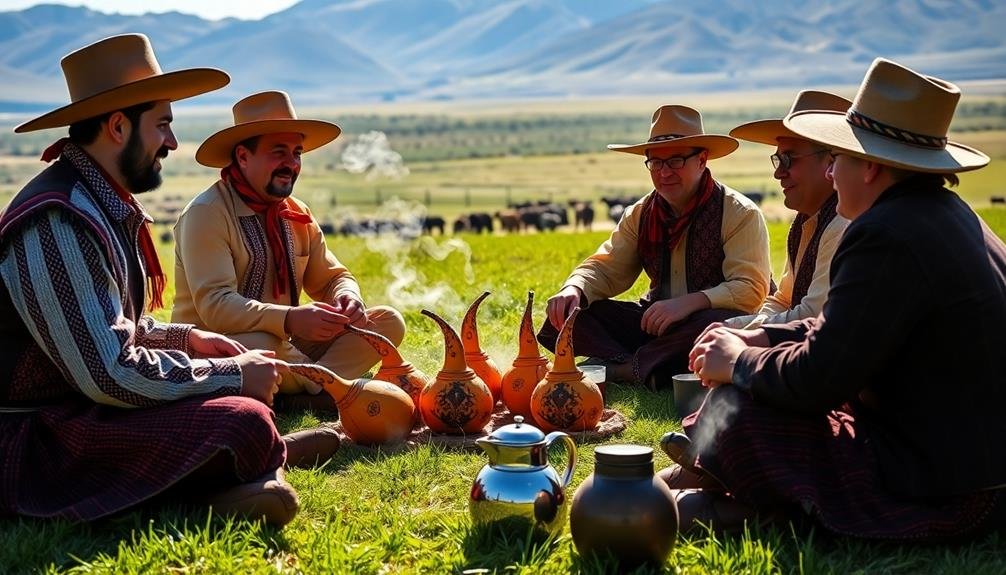
You'll find the Argentine mate sharing circle to be a unique social ritual centered around the preparation and consumption of yerba mate.
As you participate, you'll observe the cebador (server) carefully preparing the mate gourd with loose yerba leaves and hot water, then passing it around the circle.
You'll notice how this practice fosters connection and conversation, as participants share the same gourd and bombilla (metal straw), creating a sense of community and equality.
Mate Preparation Rituals
Within Argentina's social fabric, the mate sharing circle stands as a cherished ritual that brings people together. As you prepare to participate in this tradition, you'll need to understand the careful preparation process. The ritual begins with the cebador, the person responsible for preparing and serving the mate.
To prepare mate properly, follow these steps:
- Fill the gourd about 2/3 full with yerba mate leaves
- Tilt the gourd to one side, creating a mound of leaves
- Pour cool water into the empty space to moisten the leaves
Once you've prepared the mate, you'll insert the bombilla (metal straw) into the moistened area. The cebador will then pour hot water (around 70°C) over the leaves, filling the gourd about 3/4 full.
They'll take the first sip to verify the mate is properly prepared before passing it to others in the circle.
As you receive the mate, you'll drink the entire contents through the bombilla before passing it back to the cebador for refilling. This process continues, fostering conversation and connection among participants.
Social Bonding Elements
The Argentine mate sharing circle fosters deep social connections through its unique rituals and unspoken rules. As you participate, you'll notice the circular arrangement that promotes equality and inclusivity among participants.
The cebador, or mate preparer, takes on an essential role in serving others and maintaining the flow of conversation.
You'll observe a strict etiquette that governs the sharing process. Always pass the mate to your right, and don't move the bombilla (metal straw) when it's your turn to drink. Remember to say "gracias" only when you're finished, as it signals you're bowing out of the circle.
The shared gourd creates a sense of intimacy and trust among participants. As you sip from the same vessel, you're engaging in a centuries-old tradition that breaks down social barriers.
The ritual encourages open dialogue and storytelling, allowing you to form deeper connections with friends, family, or even strangers.
In Argentine culture, refusing an offer of mate is considered impolite. By accepting, you're embracing the spirit of community and hospitality that defines this cherished social custom.
Korean Tea Ceremony Etiquette
How does one navigate the intricate world of Korean tea ceremonies? You'll find that Korean tea ceremonies, known as "darye," are steeped in tradition and respect. As a guest, you're expected to follow specific etiquette to honor the host and the ceremony itself.
When you enter the tea room, remove your shoes and sit cross-legged on the floor. The host will prepare and serve the tea, typically using a small teapot and cups. You should accept the tea with both hands, showing gratitude with a slight bow.
To fully appreciate the Korean tea ceremony, remember these key points:
- Silence is golden: Maintain a calm and quiet atmosphere during the ceremony.
- Observe the tea: Take a moment to admire the color and aroma before sipping.
- Sip mindfully: Take small, deliberate sips to savor the flavor and show respect.
As you participate, you'll notice the emphasis on mindfulness and connection. The ceremony isn't just about drinking tea; it's a meditative practice that fosters harmony between people and nature.
Thai Cha-yen Social Ritual
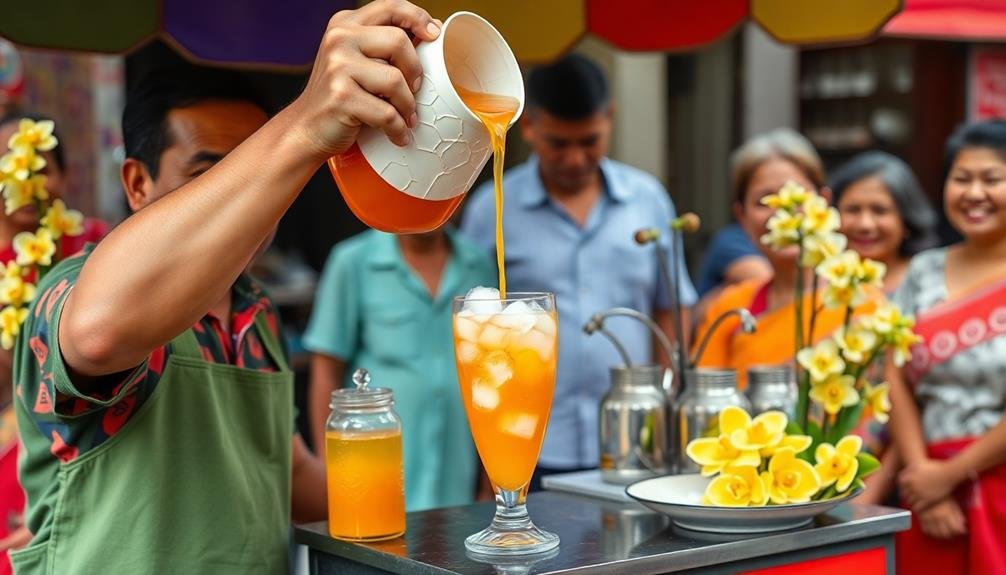
You'll find that Thai cha-yen, or Thai iced tea, plays a unique role in social gatherings throughout Thailand.
The preparation of this sweet, creamy beverage involves a careful blend of strong black tea, spices, and condensed milk, often served over ice.
As you experience Thai culture, you'll notice how cha-yen brings people together, serving as both a revitalizing drink and a catalyst for social interaction.
Iced Tea Preparation
Many Thai social gatherings revolve around the preparation and enjoyment of cha-yen, a uniquely revitalizing iced tea. You'll find this invigorating beverage at the heart of casual meetups, family gatherings, and even business meetings.
To prepare cha-yen, you'll need strong black tea, sweetened condensed milk, and crushed ice.
The process of making cha-yen is an art form in itself. Here's a simplified version:
- Brew a concentrated black tea, often using Ceylon or Assam varieties.
- Mix the hot tea with sweetened condensed milk to taste.
- Pour the mixture over a glass filled with crushed ice.
As you sip your cha-yen, you'll notice its distinct orange hue and creamy texture. The balance of strong tea, sweet milk, and ice creates a perfect harmony of flavors.
It's not uncommon to see Thai people enjoying cha-yen throughout the day, especially during hot afternoons. The social aspect of sharing this drink strengthens bonds and fosters a sense of community, making it an integral part of Thai culture.
Social Gatherings Significance
Hospitality lies at the heart of Thai cha-yen social rituals. When you're invited to a Thai home or gathering, you'll often be greeted with a rejuvenating glass of cha-yen, or Thai iced tea. This gesture signifies welcome and respect, setting the tone for social interactions.
Cha-yen isn't just a beverage; it's a catalyst for conversation and bonding. As you sip the sweet, creamy tea, you'll find it easier to engage in discussions and connect with others. The shared experience of enjoying cha-yen creates a sense of community and relaxation.
In Thai culture, offering cha-yen is a way to show care for guests and friends. It's considered impolite to refuse, so accepting the drink is a sign of good manners and appreciation for your host's hospitality.
The act of preparing and serving cha-yen is also an opportunity for the host to demonstrate their skill and attention to detail.
During important celebrations or business meetings, cha-yen often plays a central role. It's served to break the ice, foster a friendly atmosphere, and provide a moment of rejuvenation during lengthy discussions or festivities.
Frequently Asked Questions
How Do Tea Ceremonies Vary in Different Seasons?
You'll find tea ceremonies change with the seasons. In spring, you might enjoy light, floral teas. Summer brings invigorating iced options. Fall introduces warming spices, while winter calls for rich, comforting blends. Each season offers unique experiences.
What Role Do Tea Ceremonies Play in Diplomatic Relations?
You'll find that tea ceremonies play an essential role in diplomacy. They're used to build relationships, ease tensions, and foster understanding between nations. You'll see leaders sharing tea to create a relaxed atmosphere for negotiations.
Are There Any Health Benefits Associated With Participating in Tea Ceremonies?
You'll find numerous health benefits when participating in tea ceremonies. They can reduce stress, improve mindfulness, and boost social connections. You're also consuming tea, which offers antioxidants and potential benefits for heart health and digestion.
How Have Tea Ceremonies Evolved With Modern Technology and Globalization?
You'll find that tea ceremonies have adapted to modern life. They're now available online, with virtual gatherings and smart brewing devices. Global influences have blended traditions, creating fusion ceremonies that appeal to contemporary tastes.
What Are the Environmental Impacts of Various Tea Ceremony Practices?
You'll find that some tea ceremony practices have negative environmental impacts. You're using disposable items, heating water excessively, and sourcing rare teas. However, you can opt for eco-friendly alternatives and sustainable tea production methods.
In Summary
You've now explored tea ceremonies from around the world, each with its unique customs and significance. Whether you're sipping matcha in Japan or sharing mate in Argentina, you'll find that tea rituals are about more than just the beverage. They're opportunities to connect, show respect, and celebrate culture. Next time you enjoy a cup, remember the rich traditions behind this global drink. Why not try incorporating some of these practices into your own tea time?

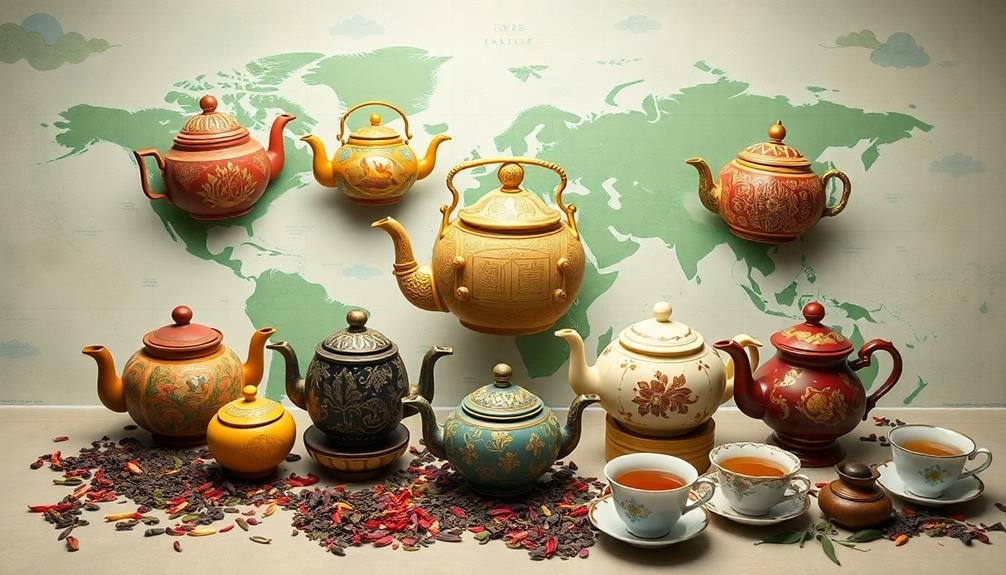
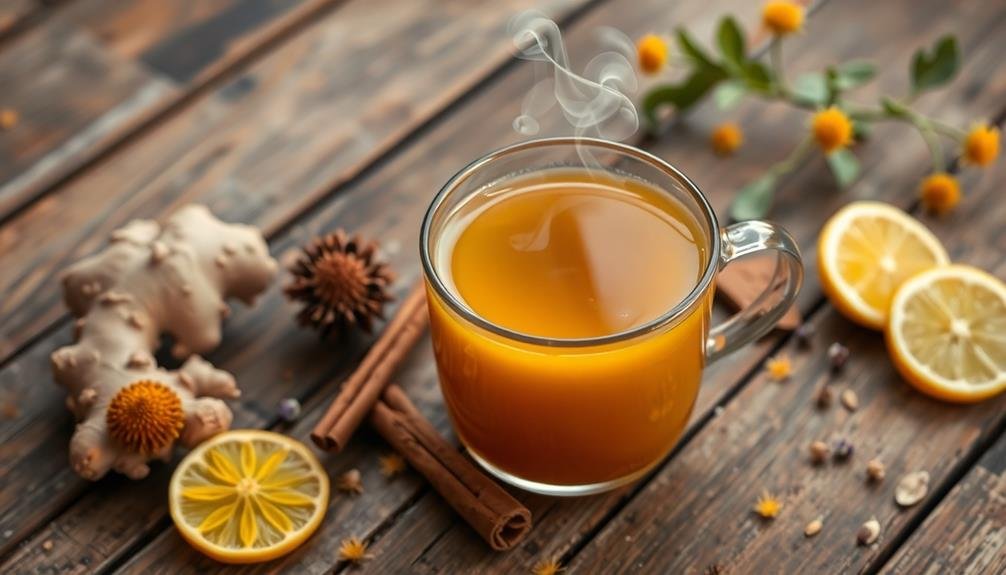
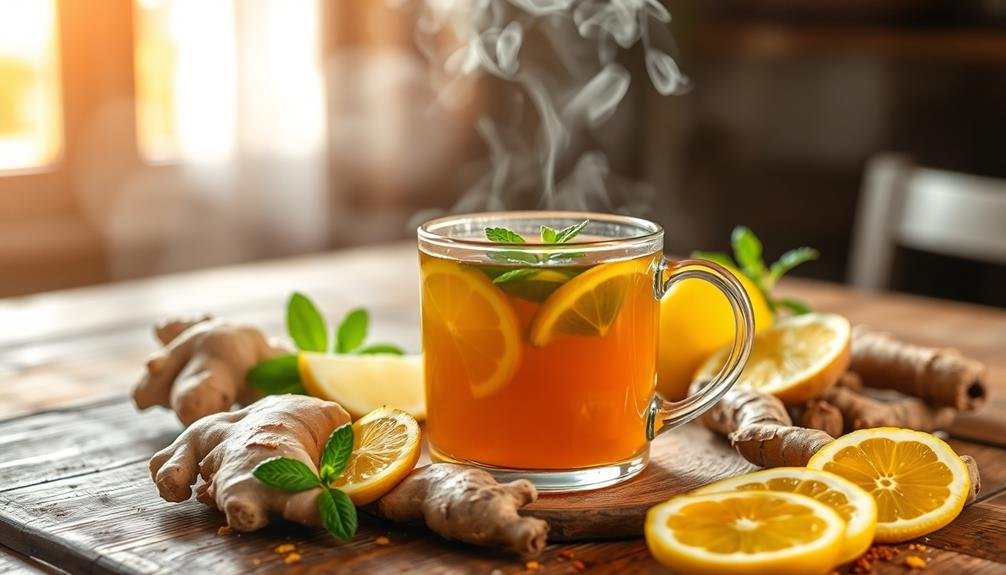
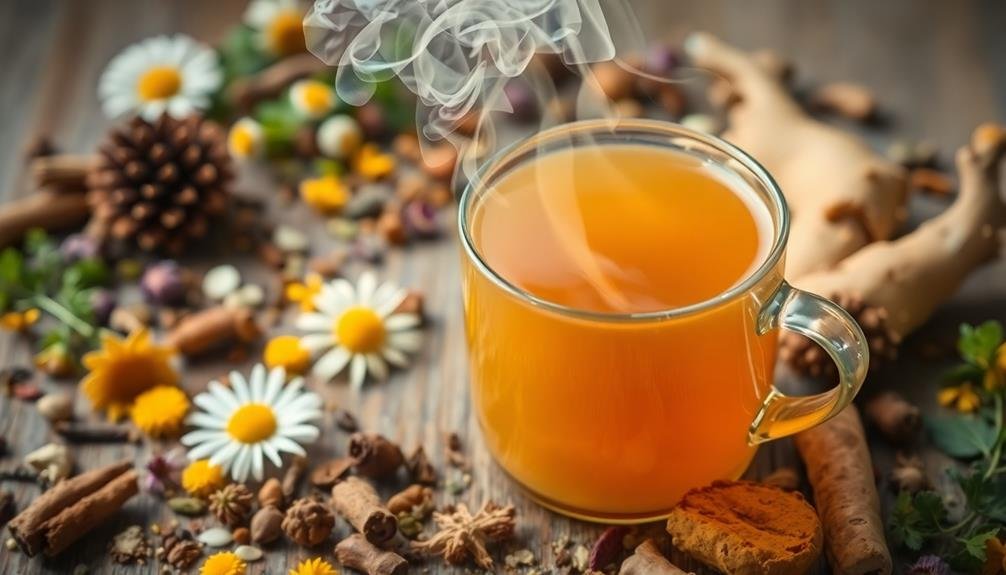
Leave a Reply